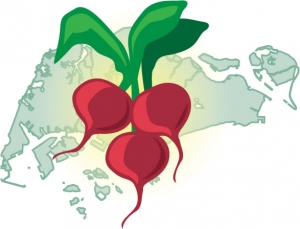Research: Urban Farming
DiSTAP will develop nano and optical sensors to measure plant metabolites in real time. These sensors will enable optimal production and rapid development of plants suitable for high-density farming.
Reduce Shade Avoidance Syndrome (SAS)
In Singapore, space is a constraint for the production of leafy vegetables and this problem can be alleviated by advancing technologies geared towards high-density urban farming. An important factor that limits high-density farming is shade avoidance syndrome (SAS). SAS is a morphological and physiological response that plants display when they are subjected to the shade formed by surrounding plants. This response includes stem and petiole elongation, hyponastic leaves, early flowering, and reduced leaf development, which results in loss of crop or vegetable yield. Over a few decades, plants that show reduced SAS are selected in order to plant in high density and produce higher yields. In view of land limitation in Singapore, it is imperative to select leafy vegetables, that show reduced SAS to sustain urban farming in Singapore. Dr. RAMANCHANDRAN’s group will take ethyl methanesulfonate (EMS) mutagenesis approach to generate varieties with reduced SAS response and study further hormonal changes in leafy vegetable under SAS inducing conditions in collaboration with Dr. JANG’s group. Dr. JANG’s group explore the role of hormones/metabolites and characterize hormonal/metabolite changes in Arabidopsis plants grown under different ratios of Red:Far-red (R:FR) light as well as different plant densities. The data obtained will be applied to develop leafy vegetables with reduced SAS.

Detect Plant Analytes under Stress
Changing physical parameters such as light, temperature, drought etc. can cause severe stress and change the nutritional quality and yield of leafy vegetables. Therefore, it is imperative to understand the optimal conditions which can increase the nutritional value without compromising yield. Abiotic stresses are also known to induce Systemic Acquired Acclimation (SAA) response that largely involves plant hormones such as abscisic acid and reactive oxygen species (ROS).
Plants produce thousands of volatile organic compounds (VOCs). Many of these VOCs are induced by specific biotic stresses. Due to this VOC profiling is an emerging field that can help indicate plants physiological health status. Additionally, plant volatiles are known to trigger defense responses in neighboring plants making them more resistance to pathogen and insect attack. This forms the basis of intercropping and has enormous potential to translate discoveries to improve disease management strategies in crops and reduce dependence on chemical pesticides. But the mechanism how volatiles interact with neighboring plants and affects its growth is still not clearly understood. Plants generally respond to biotic stresses through hormones. Uncovering links between volatile perception and hormonal signalling will be key towards understanding plants response to volatiles. Dr. SAROJAM’s group have tried to understand the effect of volatiles released from emitter plants on hormones in receiver plants under normal and biotic stress conditions.

